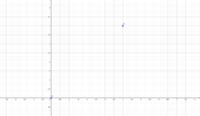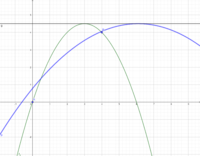first of all, I do not know if this is the right category since I don't use the English terms, please move it if it isn't.
Second of all, I'm 15, so please don't explain this too complicated to me.
I'm programming a little project and decided to go extra fancy but I got myself into trouble doing that.
Using a(x-alpha)^2+bèta
There are 2 points on a graph. One of which is (0;0) and the other one has a positive x and positive y

Now I need an parabolic equation that goes through both points. But there are an infinite amount of those equations.
So to counter that I limited the y-value of the top of the parabolic equation. Say the top is the y of point B * 1.125 following that, the equation has to draw a "mountain parabole"

Which leaves only 2 possible parabolic equations going through these 2 points and having a bèta of 4.5.
I realize the second equation doesn't go through the two points but let's just imagine it does.
I know, because that's how I want to implement it, that I need the equation with 0<alpha<4.
This gives me 0.5(x-3)^2+4.5.
Now this is reverse engineered, I took a random equation and made the points and bèta up.
But for this to work in my program I need a general formula to put in the second point, since A is fixed, and have bèta being the y-value of B * 1.125 and it outputs the function.
I've tried a lot of approaches on paper with my dad already but none of them worked out.
I am convinced this is possible.
Can anyone help me with this?
Second of all, I'm 15, so please don't explain this too complicated to me.
I'm programming a little project and decided to go extra fancy but I got myself into trouble doing that.
Using a(x-alpha)^2+bèta
There are 2 points on a graph. One of which is (0;0) and the other one has a positive x and positive y

Now I need an parabolic equation that goes through both points. But there are an infinite amount of those equations.
So to counter that I limited the y-value of the top of the parabolic equation. Say the top is the y of point B * 1.125 following that, the equation has to draw a "mountain parabole"

Which leaves only 2 possible parabolic equations going through these 2 points and having a bèta of 4.5.
I realize the second equation doesn't go through the two points but let's just imagine it does.
I know, because that's how I want to implement it, that I need the equation with 0<alpha<4.
This gives me 0.5(x-3)^2+4.5.
Now this is reverse engineered, I took a random equation and made the points and bèta up.
But for this to work in my program I need a general formula to put in the second point, since A is fixed, and have bèta being the y-value of B * 1.125 and it outputs the function.
I've tried a lot of approaches on paper with my dad already but none of them worked out.
I am convinced this is possible.
Can anyone help me with this?
